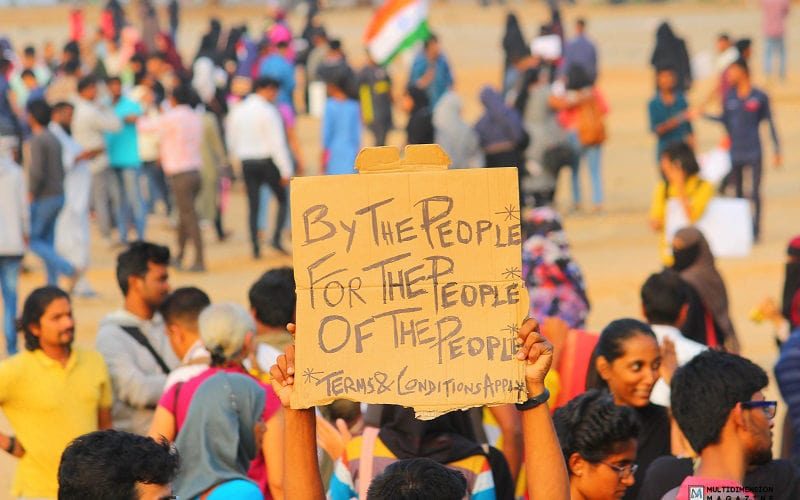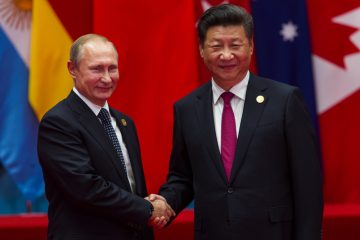Written by : Pratip Chattopadhyay
Photo : Shutterstock.com
Summary:
Democracy in India has seen many twists and turns in its evolution but under the present dispensation of Narendra Modi led NDA government, democracy in India has taken a distinct developmental turn, rhetorically in slogans like ‘development for all, development with all for trust of all’, and practically through reform measures in economic sector. As against the ‘swadeshi’ and ‘nationalist’ sentiment that BJP manifests, the present developmental turn is modelled on neoliberal paradigm of development. Quite naturally because of rootedness of Indians, farmers and commoners stages protest firmly against such developmental turn. The government backed by its single largest party stature in Lok Sabha and Rajya Sabha, dismisses all such protests as mere anti-national and does not give desired recognition to them. In this overall context, the paper tries to analyse the nature of reform the government tries to put forth in the domain of citizenship and agriculture, highlight the argument of protests and tries to link the developmental drive in the reform measures and democratic spirit ingrained in the protest sites. The paper concludes that silencing of protest in the name of developmental drive is the feature of contemporary electoral democracy in India.
Introduction:
Anti-national is the popular tag that is being placed today in India for most dissenters of BJP-led NDA government. Targeting dissenters, silencing them, ignoring theme and even vanishing them is aa feature common to both socialist and liberal democracy when they are ruled by party winning with a thumping majority almost turning democracy into dictatorship / authoritarian model of governance. Only in a competitive democracy such trends are less as noticed during the coalitional years of Indian democracy. BJP led NDA government has surpassed all previous dispensation by the degree of its a manifested indifference to protests and dissents in their quantitative and qualitative aspect. As a result even without the implementation of earlier draconian POTA or UAPA(Unlawful Activities Prevention Act) , the present dispensation due to its spread in social media, virtually develop anti-national tag targeting specific leaders of movements and sometime the movement itself. In their desire to silence protest, dissent and criticisms, Prime Minister Modi coined a term ‘movementarist’ or those who earn their repute in spreading the vibes of movement-virus in society. The present government introduces Citizenship Amendment Act in 2019 December and Reform in Agriculture in 2020 December, both generating nationwide protests and attracting international audience to the chaotic condition that protest movements put Indian democracy into Indian democracy is known for its accommodativeness and plurality. The present picture is one of centralization, and concentration of decision making space in the sphere of narrative of a singular party, i.e. BJP. The tendency to designate anti-national to dissenters is rampant today due to the presence of BJP version of nationalism., which is particularistic vision of national pride as propagated by specific nationalists believing in the disciplined version of nationalism ass spearheaded by RSS and Hindhu Mahasabha. On the contrary, nationalism refers to autonomous voluntary and free-flowing expression of collective opinion against a particular event/agent/policy/issue. Therefore in India today we find tussle between two concept of nationalism – BJP brand of nationalism highlighting ‘closure’ and Western version of nationalism highlighting ‘openness’. So BJP is reflecting opposing tendency – on one hand it reflects ‘swadeshi’ version of nationalism and on the other it reflects ‘videshi’/’foreign’ version of development that tries to introduce foreign multinational companies in Indian domestic economy modelled on neo-liberal economic paradigm. Indian model of development is that of village-based self-sufficient economy paradigm as delineated by Mahatma Gandhi. Today ther structure of indigenous developmental model is on a debate but the mainstream policy making elites like the BJP and Congress people have little against the neo-liberal developmental path. The Marxist political parties critiquing that path again does not highlight the Gandhian paradigm of development which calls for raising the voice of people in development and not silencing the voice which is happening in India today under BJP. Therefore in understanding the governments’ stand on criticism and usage of anti-national tag, one needs to revisit the paradigm of development.
The Development of Citizenship:
In order to sanitise the population in India, in order to slim-trim them. Government of India announced the CAA (Citizenship Amendment Act) in December 2019 to identify Bangladeshi, Pakistani and Afghanistan Muslims settled in India without valid reason, lineage and identity and send them to their country of origin. In doing that the Government started to obtain identity proof of forefathers of Indians in border states particularly in Assam as in 1986 the citizenship amendment act have been proposed to filter the Assamese and Bangladeshi migrants who came and settled during 1976. The present nature of the Act pan-Indianises the separation of Indians from other migrants from neighbouring countries. This act propelled nationwide protest in the form of anti-CAA movement. The crux of the protest was unnecessary harassment of citizens to obtain documents of their forefathers which usually remains undocumented and uncalled for in their evolution of family citizenship. The protests led to introduction of two new sites of protest namely Shahginbagh and Jamia protest site. While the former was purely pro-Muslim conglomeration reflecting the anti-Muslim orientation of the Act, the latter was student-protest on the amendment. Both the movement ended in a fiasco. While the Sahinbagh protest site ended with an ensuing riot like situation due to a rally of Home Minister Amit Shah in the capital in mid February 2020, the Jamia protest site had to withdraw due to the Covid outbreak.
The Development Argument in Farm Laws:
The other debated and protested Bill is the Farm Bill of September 2020 which efforts to put an end to the minimum crop price that the farmers were destined to get from the government fair price centers. Also it tries to check the role of mandi controllers on the stocking of vegetables and other farm outputs. Lastly it tries to bring in foreign multinational companies in an agreement with the farmers about the nature and quantity of crop to be harvested. While the government highlights these reforms as an attempt to ‘liberate’ the farmers from a fixated nature of earning from farm yields, the farmers on the contrary are in an angst about the possible long term uncertainty on their nature, quantity and earning from farming. The implied ‘long term’ reform effect of the farm laws and the explicit ‘short-term’ anxiety of the farmers, led to a thunderous protest for a long duration in the winters in streets and continuous series of talks between farmer representatives and government. The deadlock would not have come to an end but due to the most adventurous protest effort to raise farmer flag in Red Fort beside the national flag on Republic Day. This incident triggered immediate tagging of some important leaders like Yogendra Yadav(President of Swaraj India) as ‘anti-national’ by government and immediate nationwide criticism of the government about such tags to leaders who were nowhere associated with the adventurous protest move leaving the main makers of it away from legal entanglement. This incident forced the Supreme Court of India to put a restriction on the new articles of Farm Law and asked the government to engage with the representative of farmers on the sections of disputes and agree on a meaningful solution in the new Farm Act. The following twitter tussle among celebrities from outside India supporting the cause of the farmers and celebrities within India support the cause of the government, raised questions about celebrities in India like Sachin Tendulkar and Sourav Ganguly who remain otherwise politically neutral to get involved in such twiterriti. It can be assumed that government is getting desperate to involve celebrities to move away the media and public gaze from the main agenda of discussion – promptness of the government to silence protest by using anti-national tag.
Anti-national within Indian Legal Framework:
The buzzword, anti-national has risen to new ranks in the Indian political vocabulary. It roughly began with the killing of a rationalist, M.M. Kalburgi on August 30, 2015. The word anti-national gained prominence as a reaction against actor Aamir Khan and his wife regarding their statements about India being an (in)tolerant nation in November 2015. The public debate on (in)tolerance continued with literary figures returning their awards as a protest against the government for indulging in majoritarian politics and celebration of the killing of a Muslim man for allegedly eating beef. Simultaneously, the students’ movement was labelled anti-national after the suicide of Rohith Vemula, a student from a minority community who took matters in his own hands after being systematically ostracised by dominant caste peers and university administration. The tagging and branding of persons as anti-national reached its climax on February 9, 2016, when sedition charges were filed against the students of Jawaharlal Nehru University (JNU) over a doctored video. At one point in time the term “Anti-National” was part of the Indian Constitution itself: Article 31-D was added during the Emergency by the 42nd Amendment, to basically render laws for made for “prevention or prohibition of anti-national activities” exempt from judicial review under Articles 14, 19 or 31 of the Constitution. in Priya Parameswaran Pillai [2015, Delhi]. Here, a Look-Out Circular had been opened against the Petitioner which barred her from leaving India. One of the purported reasons was her engagement in “Anti-National” activities, which according to the government was her intention of talking about matters of Indian state policy on before a committee of British parliamentarians, which had the “potentiality of degrading the image of India in the eyes of foreign nations, leading to a regression in the country’s economic activities and endeavours…”. Furthermore, on September 5, 2017, Gauri Lankesh, a journalist was shot dead allegedly for her anti-national activities and writings. While there is a clear and growing global consensus on the draconian nature of sedition laws, they are being used ex-tensively to curb the right to free speech in India. In January 2019, youth leaders Kanhaiya Kumar, Umar Khalid and Anirban Bhattacharya were arrested by the Delhi Police for raising “anti-national slogans” at a gathering in the Jawaharlal Nehru University, New Delhi, in 2016. The section of IPC under which they were charged is the now infamous Section 124 A of IPC, 1860. As per this Section, a crime of sedition is committed when an individual through words, signs, visual representations or any other means causes hatred, contempt, disloyalty or feelings of enmity towards the lawfully established Government of India. The punishment is heavy—a convicted person can face up to three years imprisonment in addition to paying a fine. Section 124 A has become a tool of harassment by ruling governments, rather than being a safeguard against truly disloyal and dangerous citizens. Members of Parliament have introduced multiple private bills advocating either for an amendment (to include the aspect of inciting violence) or repealing the law itself.
Towards a Developmental Democracy?
Both the Act- Citizenship Amendment and Farming – are based on the reform measures of government to entrench development in the country, a development model which is far from indigenous. This duality of practicing neo-liberal developmental model and rhetorising swadeshi model of development is the crux of BJP led NDA government’s effort to democratize Indian society where development minus protest will be the signpost, i.e. a developmental democracy. In order to silence any effort to expose this duality, the present government of India is hell bent to use anti-national tag to stifle any voice of protest. In their narrative of democracy, protest is becoming an element of spectacle to be brushed aside by mere electoral majoritatinism of Lok Sabha seats. In this majoritarian parade of BJP led NDA government, the ‘other’ voice in framing laws and transforming them into Acts, are hardly taken into account, leading ‘outliner’ elements from protest section to take adventurous steps like in Red Fort. Prime Minister far from sympathizing with the cause of these protests coins a new tag of ‘protestarians’ (group who lives and earn repute by channelizing and propagandizing protests / movements’ and therefore are depended selves) to demystify any nationwide acceptance of the protest and the cause of the protests. This ignorance culture towards opposition views is the new norm in India where the central government celebrates their own conception of ‘development’ and ‘democracy’ where ‘silence’ and ‘acceptance’ are the watchwords although the desired and demanded requirements are development that is indigenous and inclusive and democracy that is argumentative and accommodative. But being the single largest party in Parliament, why should BJP care cares for percentage of vote figures and indices of satisfaction and supportive mindset of society at large? Therefore the saga of ‘developmental democracy’ tailored by BJP and effort to silence protest/dissent by extensive use of anti-national tag and Acts on ‘protestarians’ continues in Indian society presently.
(The views expressed in this article are the author’s own and do not necessarily reflect Multidimension’s editorial stance.)
About the author :
Pratip Chattopadhyay
Assistant Professor, Dept. of Political Science, University of Kalyani, West Bengal, India.
References:
1. Purohit, Pradyumna Anil, ‘When the Indian Constitution Defined ‘Anti-National’,
2. Reddy Akhileswari, ‘Sedition: Anti-national abuse’,
3. whats-in-a-name-a-lot-especially-if-that-name-is-anti-national




